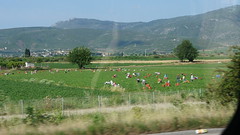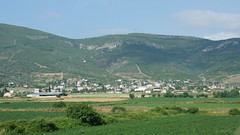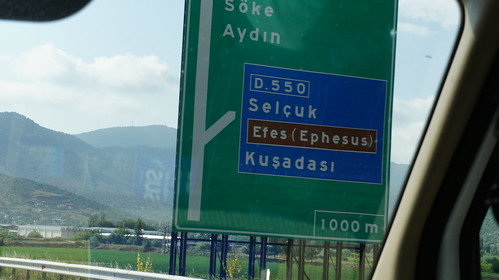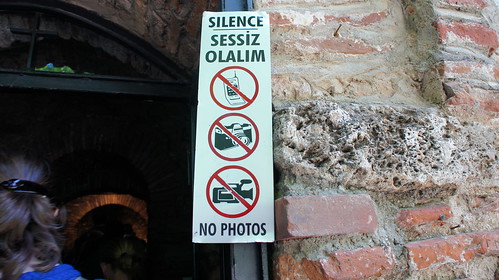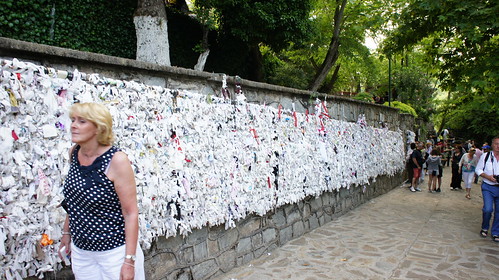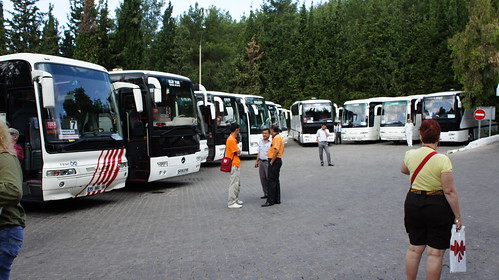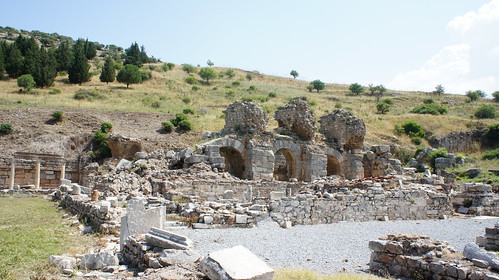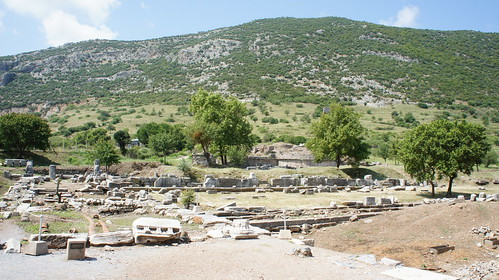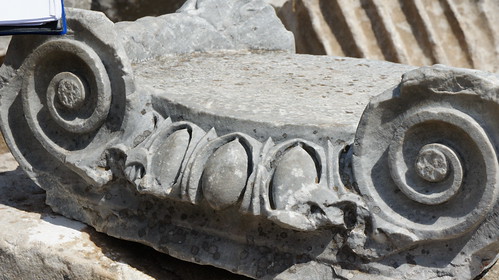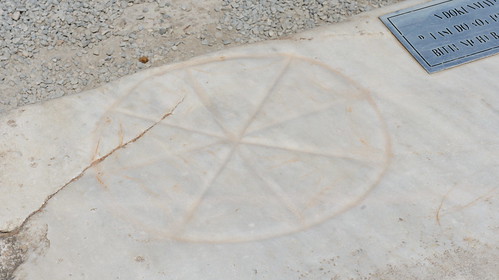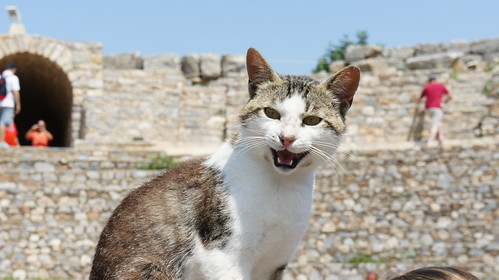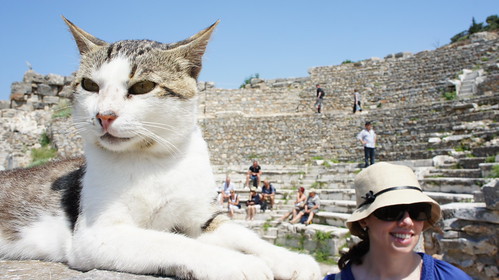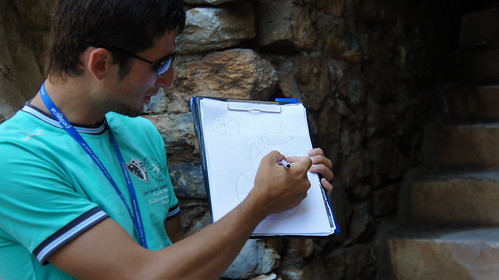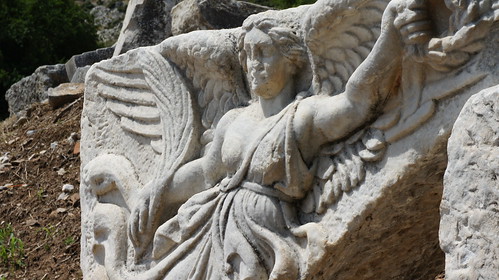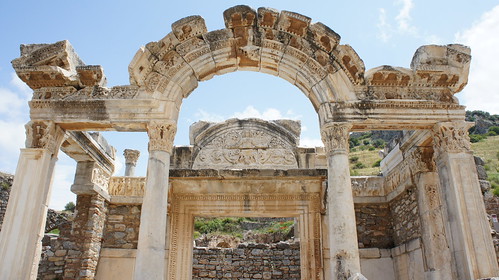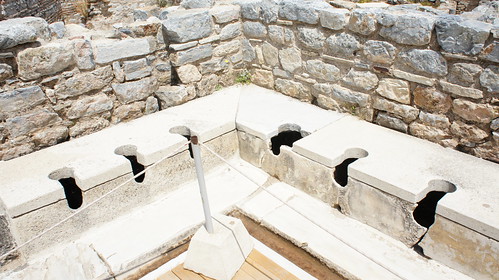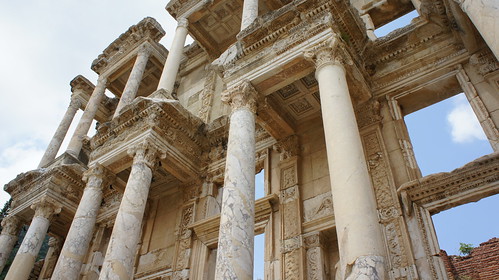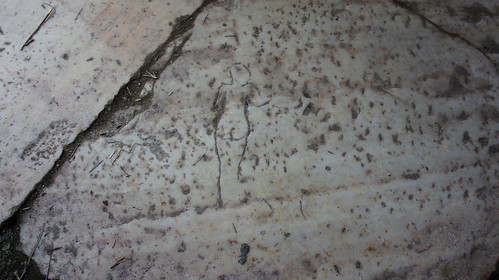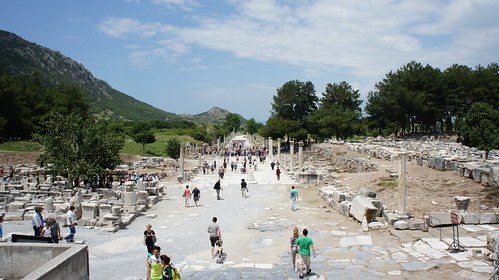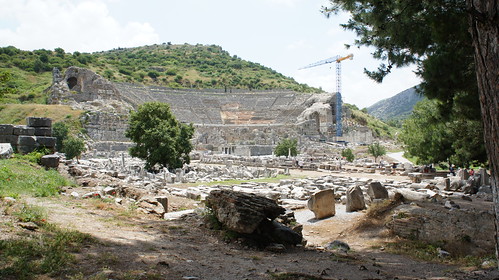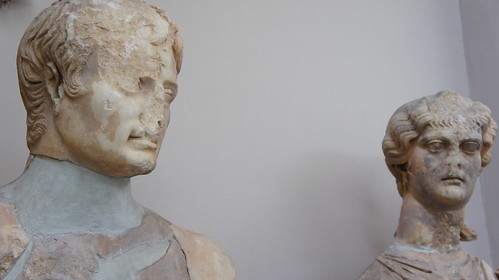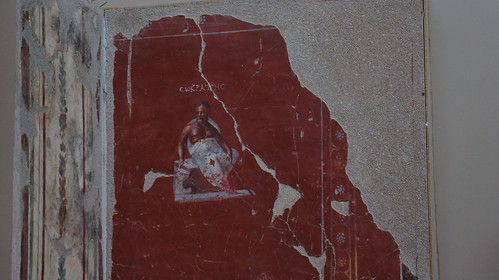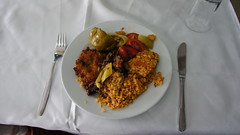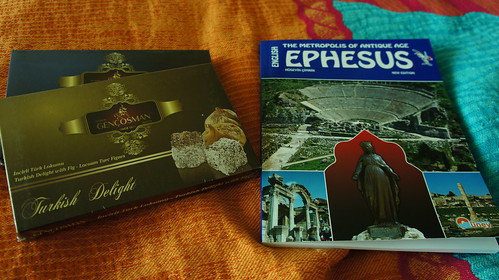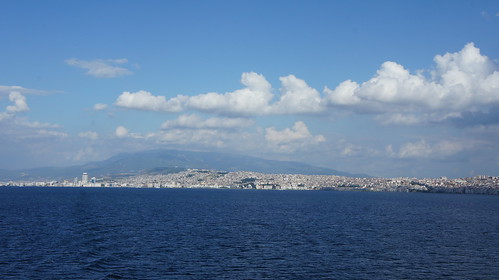After a night crossing the Aegean Sea, we arrive at Izmir, a sprawling port city on the Turkish coast — but our real destination is a bit farther south: the archaeological site of Ancient Ephesus. Uncertain of our transit options I’ve booked a full day with No-Frills Ephesus Tours, a tour agency that promises excursions without the shopping stops so common to these trips. We’re here for history, not high pressure rug sales.
Our tour guide is named Octavius — “Oktay” for short. He meets us at the port and takes us to an air conditioned van that smells just faintly of scented tobacco smoke. From there it’s about an hour’s ride across the lush Turkish lowland countryside to Selçuk, the town near Ephesus, where we pick up two more guests, a couple visiting from New York.
First stop near Selçuk: Artemision, the Temple of Artemis. Originally a massive Greek temple and one of the Seven Wonders of the Ancient World, today all that stands there is a single reconstructed pillar, topped with a stork nest and surrounded by damp marshland. In the distance, the Grand Fortress of Selçuk sits atop a hill, near the ruins of the Basilica of Saint John — ostensibly the apostle’s final resting place.
Back into the van, and a trip up Mount Koressos, and we arrive at what they call Meryemana, the House of Mary. The story goes that Saint Anne Catherine Emmerich had a vision of Mary living in a house on a mountain overlooking Ephesus. The ruins of a structure were later found in the location she had described, with a 5th Century bronze Mary statue lying in the ruins, and the building was restored as a reconstruction of Mary’s House and turned into a pilgrimage site.
Myself, I’m skeptical, given that Emmerich transcriber Clemens Brentano didn’t speak in her Westphalian dialect, only took notes on their conversations post facto, and may have fabricated certain material. While it’s reasonable to assume that Mary could have settled and died around Ephesus under John the Apostle’s care, the discovery of the structure could just as easily have been a case of confirmation bias. The statue indicates that Marian worship occurred in the building at some point, but not necessarily that it was Mary’s home. At the same time, display boards in various languages along the queue area give well-entrenched rationalizations to keep the house as a pilgrimage site. Meryemana has become an important pilgrimage venue for local Catholics and Muslims alike — and also a generous boon to the livelihoods of local tour guides.
The line moves quickly, and we pass through the house in less than a minute: a foyer, an anteroom, a small nave with an altar and a bronze statue of Mary (definitely not a 5th Century statue), then a little exit room with a print of a Byzantine painting showing Mary lying in state after her death, and then we’re out again. Nearby there is a spring of holy water, a wishing wall, and a “Virgin Mary Cafe.” And a cat.
What truly awes my spirit about this place is the sheer number of tour buses squeezed into the Meryemana parking lot.
Back down the mountain we go, and ten minutes later we are at Ephesus itself — or at least, what part of it has been uncovered by archaeological digs.
We enter through the Magnesia Gate and walk through what was once the Upper Agora.
Oktay informs us that there will be two recurring visual themes here: round bull testicles that echo the many breasts of Ephesian Artemis, and the Ichthus Wheel that signifies Christianity.
A cat is presiding over the Odeon.
Ichthus wheels are carved infrequently into walls around the Odeon. Oktay explains the shape of the wheel and its relation to the letters of Christ’s name and the iconic Jesus fish which Christians drew to identify themselves.
In the nearby Prytaneion, the goddess Nike points the way downtown.
Down Curetes Street we go, past the Temple of Hadrian, and a public latrine where the men of Ephesus used to wipe up with communal sponges.
At the end of Curetes we arrive at the Library of Celsus — but not the actual library itself, whose interior was destroyed in a 3rd Century earthquake and fire, and the facade destroyed in Byzantine days. The current facade is a 20th Century restoration, yet faithful and imposing nonetheless.
From the Library, Curetes Street turns into “Marble Road,” passing by an old brothel (right beside the public latrine) and the Great Theater of Ephesus, where tradition places Saint Paul’s evangelical addresses to the Ephesians — and the start of the Silversmiths’ Riot.
Thrilling as it is to stand where the Biblical Paul once preached, it’s also a bit amusing to go into the backstage tunnels and see graffiti of nude women carved into the marble, indicating the Theater was also a venue for more prurient cultural displays.
Farther down from the Theater we reach the Arkadiane, the harbor street which once connected the town to the waterfront. Those banks are 5 miles away now, thanks to silt from the Cayster River, a relandscaping which over the millenia led to Ephesus’ eventual decline and abandonment. Today, the Arkadiane ends in a landlocked marsh, inaccessible right now — but the Imperial reenactors make up for missing that view.
We pass by the Lower Agora on the way out, and what used to be a marketplace. The ruins are a bit more disorganized here, but the view back towards the Great Theater is amazing.
From here we’ve seen most of Ephesus. As we walk down the trail towards the north exit, Oktay points out a site on the mountainside, the Cave of the Seven Sleepers — actually just one of several traditionally conjectured venues for this Rip Van Winkle-like religious legend. No time to visit today, though. We exit Ancient Ephesus, walk through a bazaar of Turkish food stalls and Ephesian merchandise stands, and reboard our van in another of those epically crowded tour bus parking lots.
Next stop: the Ephesus Archaeological Museum in Selçuk, home to artifacts recovered from the ancient city and other digs all around the area. Of note is the wall painting of Socrates from the Terrace Houses, the many-breasted depictions of the goddess Artemis, and busts of Caesar Augustus and his wife Livia. Oktay likes the Caesar bust, especially, since Augustus’ real name was Octavius. Also fun: Priapus.
For lunch we ride over to Efes Sultan, a Turkish buffet restaurant in Selçuk. Interesting thing about Turkish food: they don’t normally eat a lot of red meat due to high taxes on beef importation (and pork pretty much doesn’t exist for obvious reasons). As a result the buffet is a healthy mix of grains and vegetables with the occasional kofte meatball or ground chicken filling, all quite varied and delicious with a side of spinach salad in olive oil and sweet pomegranate syrup — and a bottle of Efes Pilsen.
I also meet the owner of the travel agency to iron out some Paypal issues, and chat a bit about the cultural uniqueness of a tour company that offers no-shopping excursions. (It actually costs a bit more to run a tour without the shopping stops since sweetheart deals with high-pressure rug sellers are the norm in this region, but I’m happy to pay the extra cost to trade the sales for more history.)
After lunch, about an hour drive back to Izmir and the cruise port. As a parting gift from No-Frills Ephesus Tours, Oktay gives us two boxes of Turkish Delight and an Ephesus guidebook.
Nothing quite like sitting on a cruise ship stateroom balcony, chewing on Turkish Delight and reading about Ephesus, while the gleaming port of Izmir slips behind the horizon.
